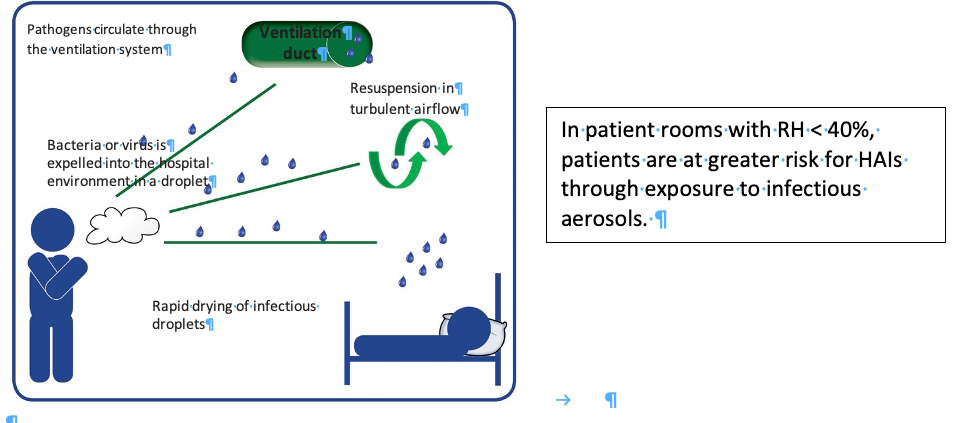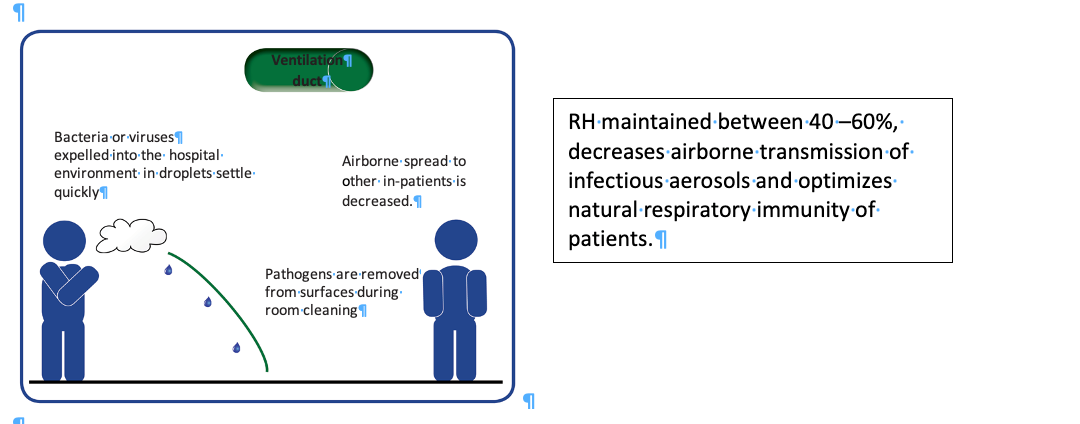Why Water Vapor in Hospitals Matters
Where can we find data on whether or not water vapor is necessary for humans residing in buildings? One great place for such research is the hospital. There is a tremendous amount of data that is collected from one type of hospital building occupant—the patient.
Despite a clear requirement of water vapor during the human breathing process, the presence of water in the gaseous state, or humidity, in buildings has acquired a bad reputation. Even hospitals prefer to turn humidification systems off in patient-occupied spaces. The reasons for a dislike of humidification are complex, but the lack of understanding about health problems associated with low humidity has resulted in harmfully dry indoor environments. In fact, we now know that low humidity strengthens infectious microbes and weakens the human immune system.
This is especially problematic in regions with cold winter months when outdoor air is heated to comfortable indoor temperatures and the indoor relative humidity plummets to values of less than 30%. Are our prejudices about indoor humidity correct? Turning to scientific data is essential when trying to differentiate between subjective opinions and best-practice actions based on objective data.
Data From Patients
Where can we gather relevant data on water vapor and occupant health? One great place for such research is the hospital. The reason for this is that we collect reams of data from the most relevant occupant—the patient. From vital sign measurements, blood cell and chemistry analysis, microbiology culturing of every imaginable fluid to imaging and other diagnostic procedures, we gather tremendous amounts of data from the patient. This wealth of data on humans can be correlated with indoor air metrics to understand whether our views on best indoor air quality is truly beneficial to people.
Currently, clinicians caring for in-patients focus on medical and surgical interventions that will hopefully heal the patient. Meanwhile, hospital facility managers follow building standards that are not necessarily based on medical data. Caught in the middle are infection preventionists (IPs), the team that strives to protect the patient from encountering infectious microbes during their inpatient treatment that could result in a healthcare-associated infection (HAI). By having an understanding of how the built environment influences clinical outcomes, the infection control team can utilize a whole new set of tools for reducing HAIs. We are now learning just how impactful these measures are.
A 2014 landmark study in a tertiary care hospital analyzed patient room metrics in conjunction with HAIs in the patients occupying those rooms. Data on clinician and visitor activity, indoor air metrics, and new infections in the patients inhabiting those rooms was logged for 1 year. Rigorous statistical testing using multivariable regression analysis was applied to the data to look for independent correlations between the indoor environment and patient HAIs. To the surprise of the author, the most significant correlation with which infection rates was room relative humidity (RH) less than 40%.1 When the patient room RH was above 40%, the infection rate was close to 0.
Another study following this protocol was done in a nursing home in 2015. Once again, when the indoor RH fell below 40% the infection rate was high.2 The ideal zone of indoor humidity for best patient outcomes was found to be RH 40%-60%. Although these 2 studies reveal powerful correlations between dry indoor air and poor patient health, they do not prove causation because of the lack of data from a simultaneous control group.
In 2016, researchers at the Mayo Clinic published a study that showed a causal relationship between low indoor humidity and increased infectivity of the influenza virus in preschool children.3 This study compared indoor RH of 20% or 45% with the number and infectivity of influenza virus in classrooms and with the number of school days missed by the children in each area. The humidified rooms had fewer and less infectious viral particles as well as significantly fewer children absent from influenza illness.
The infectivity of airborne viruses and bacteria depends on the transmission and infectivity of pathogens and on the vulnerability of the secondary human host.
Vapor Equilibrium
When a person with a respiratory infection breathes, talks, or coughs, their airways expel thousands of droplets containing saliva, mucus, and embedded microbes into the ambient air. Moisture levels in the expelled droplets quickly equilibrate with ambient air water vapor through condensation and evaporation. Thus, vapor equilibrium, or RH, of room air determines the resulting droplet size, concentration of salts and the viability of the infectious microbe.
When expelled droplets encounter dry room air with RH less than 40%, they instantly shrink by roughly 90%. The resulting tiny droplet nuclei with diameters less than 0.5 microns can remain airborne for extended periods of time and be carried over great distances.
Prior to the use of genetic analysis tools, microbiologists determined the infectivity of these tiny droplet nuclei through the ability to grow the organisms on incubated petri dishes, known as tissue culture. This technique vastly undercounted the number of potentially infectious particles. We now supplement tissue culture with techniques that identify the genetic material of particles. This has revolutionized our thinking about microbes, human health and the indoor environment. For example, we have learned that infectious microbes in dry airborne aerosols are often temporarily in a dormant state, yet highly infectious when rehydrated.
When desiccated droplet nuclei suspended in low RH ambient air are inhaled by a secondary host, the droplet rehydrates in moist airways and many pathogens are able to begin a new infectious cycle (Figure 1).

Conversely, when ambient RH is above 40%, the respiratorydroplets maintain larger diameters of approximately 50 microns. Becausethe droplet diameter dictates the settling distance and rate,these larger droplets land on surfaces within 4 to 6 feet oftheir source where they can be efficiently removed with surface cleaning. Clearly, as transmission through room air or mechanical systems is decreased, the possibility of a secondary host being exposed is proportionately decreased (Figure 2).

Air sampling that mistakenly excludes the dormant pathogens in droplet nuclei underestimates the infectious load of indoor air particles. In fact, microbiologists now conclude that most infectious microbes that can transmit disease through contact also move through the air at some point between the initial host and a secondary host. Because of this airborne component of disease transmission, even the strictest adherence to hand, surface and short-range droplet hygiene will not reduce the incidence of infectious diseases as much as when the airborne route is also managed.
Not only does low indoor RH increase pathogen infectivity and transmission, it also diminishes the integrity of the human immune system. When RH is maintained between 40%–60%, the natural human skin and respiratory tract defenses and immune cell functioning are optimized.
IPs to the Rescue
In summary, the hospital’s physical environment has a significant impact on the health and healing of patients. Unfortunately, avoidable HAIs harm too many patients and cause significant waste of healthcare dollars.
By maintaining RH in patient care spaces between 40% to 60%, the transmission and infectivity of airborne pathogens will be reduced, surface cleaning will be more effective and patient immunity will be optimized.
Current indoor air guidelines for hospitals do not specifya lower limit RH in patient care areas and are evenpromoting lowering the minimum acceptable RH level inoperating rooms from the current 35% down to 20%.This is a mistake! Management of healthcare facilities mustfocus on the number one priority— patient healing.
Managing the indoor physical environment of hospitals and out-patient centers to optimize patient care is neglected. This may be because awareness of the powerful impact of indoor air quality, and specifically the value of proper humidification, on human health is lost between the silos of clinical medicine and facility management. The infection control team, once again, must come to the rescue of patients.
Stephanie Taylor, MD, M. Arch, is an infection prevention consultant at Harvard Medical School. She is also the CEO of Taylor Healthcare Consulting, a member of ASHRAE Epidemic Task Force, Environmental Health Committee and a Distinguished Lecturer.

“Ongoing Assault”: How HHS Layoffs Have Eviscerated Infection Prevention Support Across the Nation
April 1st 2025Mass layoffs at HHS and CDC have gutted critical infection prevention programs, leaving frontline professionals overwhelmed, under-resourced, and desperate to safeguard public health.
Vet IP Roundtable 2: Infection Control and Biosecurity Challenges in Veterinary Care
March 31st 2025Veterinary IPs highlight critical gaps in cleaning protocols, training, and biosecurity, stressing the urgent need for standardized, animal-specific infection prevention practices across diverse care settings.